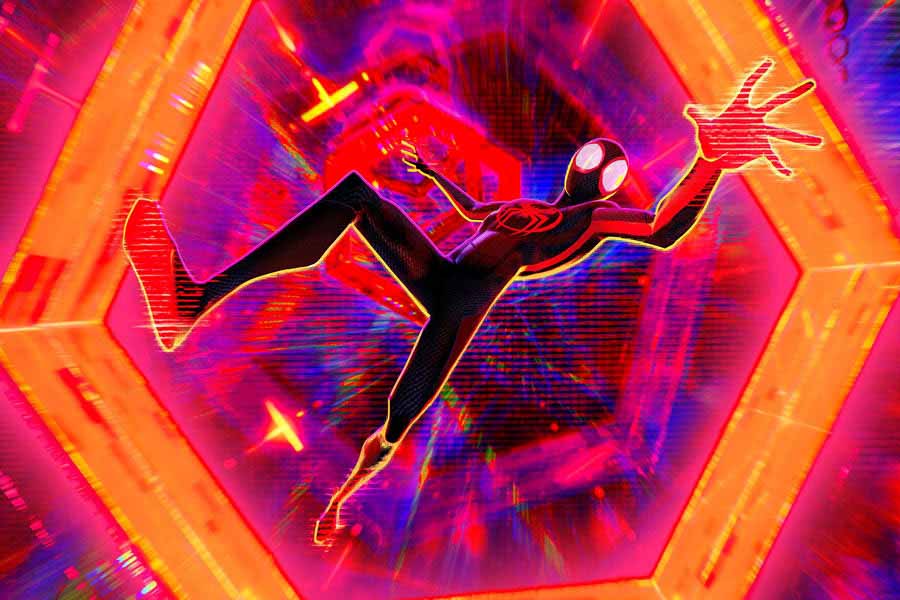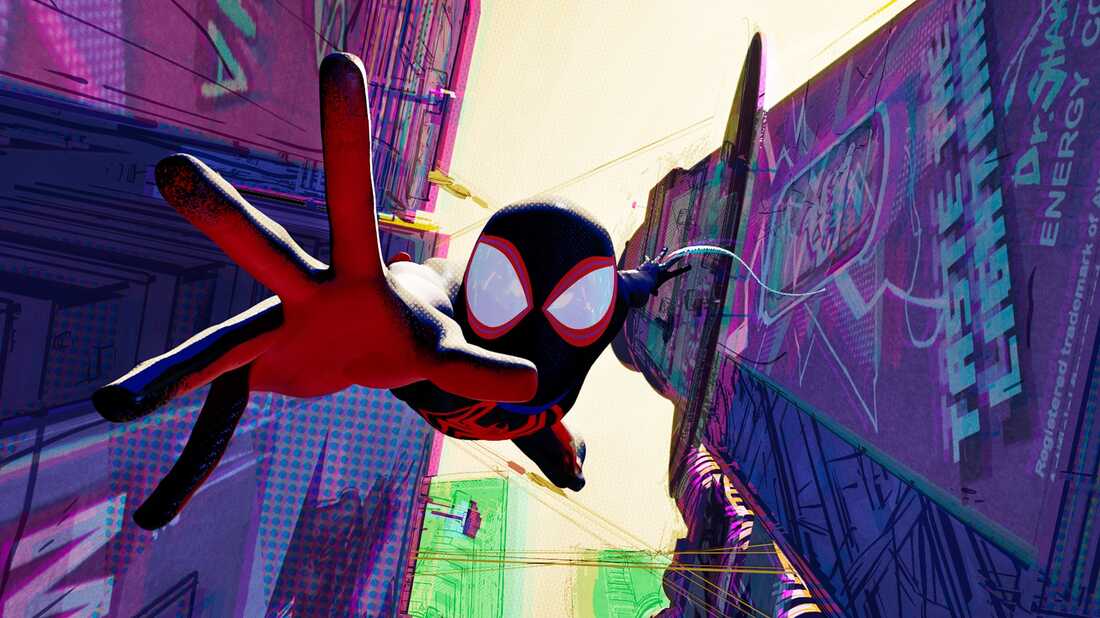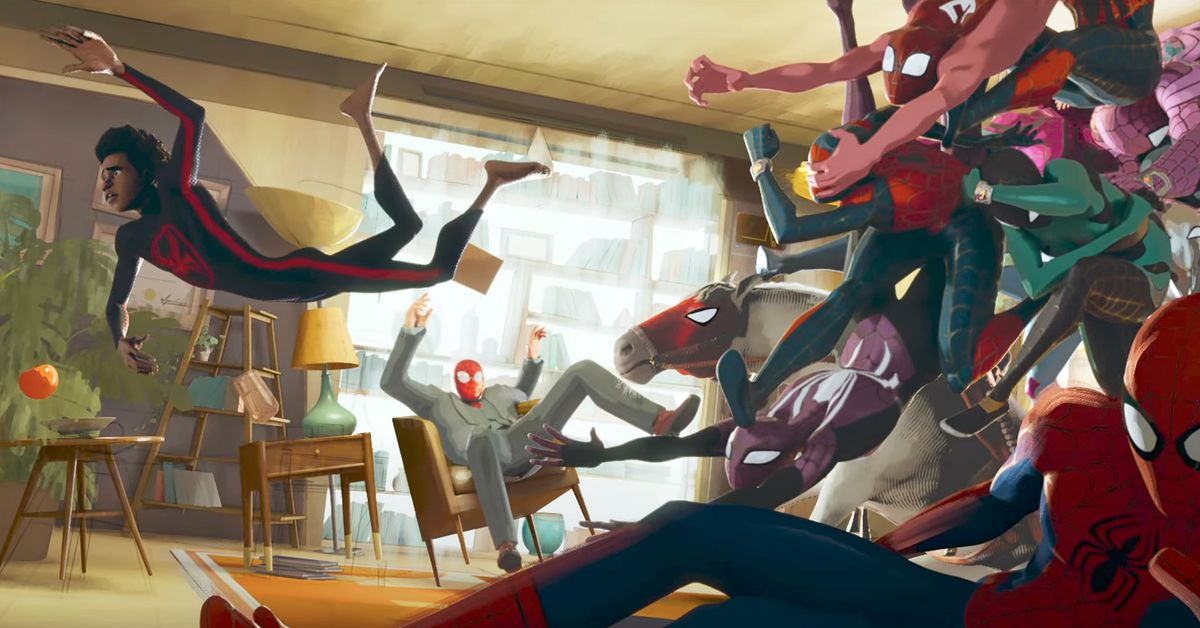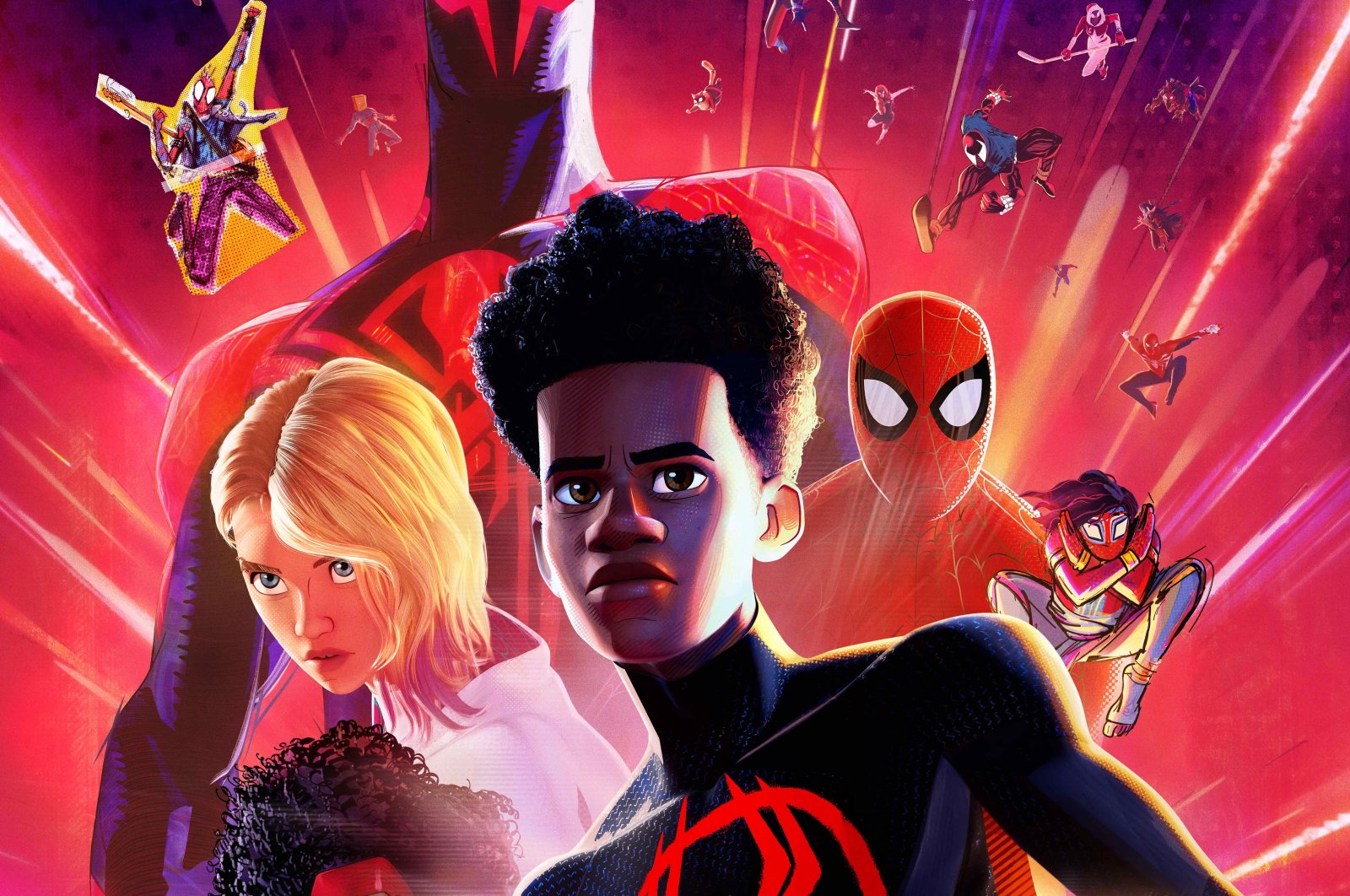With superhero movies largely dominating the live-action media space for over two decades now, it’s genuinely surprising that we haven’t had an equal crop of theatrical animated superhero productions. Television has at least seen its share of high-quality animated superhero adaptations, with gems such as Amazon Prime Video’s Invincible and Max’s Harley Quinn flexing the potential of the medium for adult superhero enthusiasts. On the big screen however, that potential has almost entirely been shouldered by Sony’s Spider-Man: Into the Spider-Verse, an experimental Sony Pictures Animation offering that ended up dazzling critics and audiences at the tail end of 2018, despite a relatively modest box office haul. It also went on to win the Academy Award for Best Animated Movie during the following Oscars.
Finally, after almost five long years, Spider-Man: Into the Spider-Verse has received its long-awaited sequel, Spider-Man: Across the Spider-Verse as well. A two-part production that originally had a ‘Part 1’ at the end of its title (the retitled ‘Part 2’ is now known as Spider-Man: Beyond the Spider-Verse, and is currently scheduled to premiere in early 2024), Spider-Man: Across the Spider-Verse brings the origin story of the animated Miles Morales toward a climax, thus throwing Miles into an even larger multiverse, one filled with limitless and exotic variants of your Friendly Neighbourhood Spider-Man.

There are many amazing feats of animation achieved throughout Spider-Man: Across the Spider-Verse, a sequel that more than rises to the challenge of outdoing the scope behind its lauded predecessor. Despite this however, this sequel’s greatest trick is that it manages to keep pace, and sometimes genuinely surpass Spider-Man: Into the Spider-Verse, a feat that I would have initially imagined was borderline impossible. Despite that, Spider-Man: Across the Spider-Verse somehow bottles lightning twice, delivering another master stroke of superhero movie storytelling that effortlessly builds upon the ideas of the first movie, proving to audiences as much as Miles himself that our first foray into the Spider-Verse was barely scratching the surface.
Spider-Man: Across the Spider-Verse could have delivered the same experience as its 2018 predecessor, and stopped at presenting a hook of more heroes and villains from the Web-Slinger’s comic book multiverse. Instead, this follow-up to Sony Pictures Animation’s stellar multiversal odyssey completely reinvents its formula, dispensing with a conventional hero/villain narrative entirely. This is despite the presence of a super-villain threat in Dr. Johnathon Ohnn, a.k.a. The Spot, voiced by Jason Schwartzman, a very obscure Spider-Man villain from Marvel Comics lore, who has the ability to open small interdimensional portals. Needless to say, this villain is a natural fit for this franchise, despite being a much lesser-known enemy in Spider-Man’s rogues gallery.
Even though The Spot would initially appear to be the central threat at the heart of Spider-Man: Across the Spider-Verse however, the character humourously isn’t perceived as a real antagonist by Miles, who instead sees the disgraced, mutated Dr. Ohnn as a minor nuisance with delusions of grandeur. This is a clever, hilarious send-up of superhero tropes, as The Spot repeatedly declares himself to be the archnemesis of Miles, despite Miles never taking the character seriously, and not even recalling who he is. Sure, this isn’t the first time that such a trope has been attempted, as 2017’s The LEGO Batman Movie (another rare animated superhero movie released in theatres), performed a similar gag with its LEGO-ized Batman and Joker, but Dr. Ohnn elevates this super-villain satire with a great retroactive twist that plays heavily into Spider-Man: Across the Spider-Verse’s themes of minor, seemingly inconsequential actions sometimes having very far-reaching consequences.
“Spider-Man: Across the Spider-Verse reframes Miles as a variant among variants; An unworthy, upstart vigilante that refuses to fall in line, and doesn’t seem to have any regard for how his actions can affect dimensions and worlds well beyond his own.”
Miles may not see The Spot as much of a worthy threat, but he nonetheless finds himself pulled by returning friend, Gwen Stacy/Spider-Woman into a multiverse-policing ‘Spider-Society’ after The Spot’s debut. In the original Spider-Man: Into the Spider-Verse, Miles got to know a select few variants of the familiar Spider-Man persona, all of which were faithful friends and allies. In Spider-Man: Across the Spider-Verse however, Miles quickly learns through Spider-Society that not every Spider-Person is quite so immediately supportive of him and his ideas. Whether it’s the tense rapport Miles develops with Hobie Brown/Spider-Punk, voiced by a standout Daniel Kaluuya, or the outright fury that Miles provokes in Miguel O’Hara/Spider-Man 2099, overseer of the entire Spider-Society, voiced by Oscar Isaac, Miles actually ends up facing much more resistance from his fellow superhero variants than he does any tangible villain in this sequel.
This is because Spider-Man: Across the Spider-Verse reframes Miles as a variant among variants; An unworthy, upstart vigilante that refuses to fall in line, and doesn’t seem to have any regard for how his actions can affect dimensions and worlds well beyond his own. To that end, there’s an inspired element of interpretation that asks whether Miles himself may be the true villain behind Spider-Man: Across the Spider-Verse, with The Spot merely being the most perceptible consequence of Miles’ own youth and arrogance. Even considering the presence of The Spot however, there is a meta narrative device across this movie’s multiverse known as ‘The Canon’, essentially fixed points in every universe’s timeline that Spider-People are forbidden to alter, lest they undo the fabric of reality.
Sure, The Canon exemplifies a chance to flex just how freely Sony can play with their Spider-Man movie license, now that they’ve built some key bridges of corporate synergy with Disney and Marvel, but even more than that, The Canon gives form to an unprecedented test for a junior Spider-Man variant; Presenting Miles the power to see behind the curtain of time and space, and questioning where the limits of great power and responsibility can truly lie for him at that point.
One major draw that Spider-Man: Across the Spider-Verse maintains from its predecessor without compromise is its outstanding commitment to stellar music and animation. Once again, Spider-Man: Across the Spider-Verse delivers some of the most mind-blowing production values in the history of Sony Pictures Animation, and with a significant budget bump following the glowing reception to its 2018 predecessor, it’s now allowed to take those production values further than ever before.
Spider-Man: Across the Spider-Verse notably brings back composer, Daniel Pemberton to score another amazing soundtrack full of instrumental and licensed music. The original Spider-Man: Into the Spider-Verse presented arguably one of the best licensed soundtracks in any movie from 2018, and Spider-Man: Across the Spider-Verse aims to do the same. This sequel’s soundtrack is filled with the work of excellent musicians, from Lil Nas X to ASAP Rocky to Becky G, and while it may not present as many instantly iconic hits as Spider-Man: Into the Spider-Verse’s soundtrack appeared to deliver in 2018, it nonetheless delivers a very strong licensed soundtrack in its own right, once again no doubt standing as one of 2023’s best licensed soundtracks in a movie. The instrumental compositions are just as superb as well, giving Spider-Man: Across the Spider-Verse a wonderful sense of weird, yet inspiring energy, helping the experience to feel grounded and full of heart, even when the visuals take audiences to some truly bizarre places.

I really have to emphasize again just how much of a visual masterpiece Spider-Man: Across the Spider-Verse often is as well. This sequel replicates and expands upon many of the visual feats of its predecessor, and pushes them even further with new methods of animation and visual flourishes. Whether it’s a Bollywood-fueled trek through the universe of Spider-Man India, voiced by Deadpool’s Karan Soni, or a dizzying spin through the physics-defying headquarters of Spider-Society itself, Spider-Man: Across the Spider-Verse never settles into a familiar or predictable animation groove. Once again seamlessly blending the most ambitious of comic book art with the most imaginative visual treks that cinematic animation currently has to offer, Spider-Man: Across the Spider-Verse sets a brilliant new visual standard as not just one of the best looking superhero productions made to date, in any medium, but also one of the best animated movies ever made to date, period!
This movie’s visuals can be so overwhelming in fact that it can almost work to its detriment at times. Several action scenes are so high-powered and zany that even the highly-honed direction sometimes strains to make it coherent. That’s sort of the idea though. Spider-Man: Across the Spider-Verse is a multiverse-themed superhero sequel that doesn’t hold back when it comes to getting weird. Even the confines of the moviemaking medium itself are blended and experimented with in all sorts of strange ways throughout this follow-up, all of which I would be remiss to spoil. Rest assured however that Spider-Man: Across the Spider-Verse is an easy contender for one of this year’s most impressive movies overall, let alone animated movies, thankfully packing in just as much substance as it does overwhelming style.
For all of its efforts to twist and break the fabric of the Spider-Man franchise’s multiverse, across the Webhead’s movies, TV shows, comic books, video games and more (all of which find some sort of winking representation throughout Spider-Man: Across the Spider-Verse), the secret sauce of this sequel is also maintained from its equally brilliant predecessor; The incredibly humanized, relatable struggles of its characters.
This goes beyond Miles himself, with Miles now having firmly settled into the role of his universe’s new Spider-Man, succeeding his world’s late Peter Parker, who was killed by Kingpin during the events of the original Spider-Man: Into the Spider-Verse. Miles faces his own relatable issues of uneven grades and parental alienation as a direct result of his superhero duties during Spider-Man: Across the Spider-Verse, on top of missing his interdimensional friends, and Gwen in particular. Miles’ problems are almost small potatoes compared to the burden faced by other Spider-People however, and even his supposed enemy, The Spot, whose unique mutation has left him permanently unable to function in society, further heightening his desire for revenge against Miles, whom he blames for his condition.
Again, it’s the fact that these larger-than-life animated characters can simultaneously feel so incredibly human that makes Spider-Man: Across the Spider-Verse so much more than a visually stunning superhero spectacle. Gwen most notably unearths several new layers to her character in this sequel, facing her own burdens as her universe’s Spider-Woman, having now lost her best friend, and practically having lost her father, a workaholic police captain who is obsessed with apprehending Spider-Woman, while remaining firmly oblivious to the fact that his quarry is his daughter. Even Gwen’s attempts to enjoy an adolescent band are quickly starting to prove difficult, leaving her more alone than ever, and in turn encouraging her to look back towards Miles, thus making Gwen’s own angst the inadvertent catalyst for so many events throughout Spider-Man: Across the Spider-Verse.
“Again, it’s the fact that these larger-than-life animated characters can simultaneously feel so incredibly human that makes Spider-Man: Across the Spider-Verse so much more than a visually stunning superhero spectacle.”
At the same time, Miguel is given his own surprisingly human portrayal as the unexpected antagonist to Miles in this sequel, quickly buckling under the burden of upholding The Canon throughout the entire multiverse. From Miguel’s perspective, Miles is the one thing standing in the way of interdimensional stability, even more than The Spot, and to some degree, Miguel is right to want Miles out of the picture. Hell, even The Spot’s perspective starts to make a surprising amount of sense when you’re exposed to it enough, further contributing to a whole multiverse’s worth of personalities that break through the exaggerated, dimension-rattling animation with a genuine sense of sobering reality.
Spider-Man: Across the Spider-Verse is certainly an incredibly fun, visually captivating roller coaster during its many action-packed and humourous moments, but it’s the quiet, character-driven scenes where the movie seems to shine even more. When everything stops, gets quiet, and two characters have no choice but to try and connect through a well of uncertain dialogue and convenient obliviousness, Spider-Man: Across the Spider-Verse does an excellent job of exploring another major theme; The pain that can come with wanting to connect, and reconnect with the people you love, while not always being sure how, sometimes ironically making the disconnection feel even more exacerbated through the process of trying.
Spider-Man: Across the Spider-Verse spins such a brilliant web of character-driven storytelling in fact that one of the only evident criticisms immediately jumping out from its narrative is the innate annoyance of this movie having to be just one half of a two-part storyline. As is disappointingly common with two-part blockbusters of this nature, Spider-Man: Across the Spider-Verse also frustratingly doesn’t find an organic or natural concluding point, instead just awkwardly ‘stopping’ halfway through a scene, rather than truly ending. Granted, the proposition that we must return next year, or whenever Spider-Man: Beyond the Spider-Verse manages to hit theatres (the ongoing Hollywood strikes and production issues could definitely affect its planned March 2024 release date at the time of writing), is a little easier to swallow when you consider how fantastic this movie is on its own merits, but despite even that, a ploy to force audiences to return for another movie next year is always going to make it difficult to fully appreciate even a story this good; After all, it’s inherently incomplete for now.
(NOTE: The ‘spoiler’ section, when clicked, discusses whether Spider-Man: Across the Spider-Verse has any post-credits scenes, whether it features any additional Marvel characters of note, and whether it sets up any future projects within its animated continuity, or within Sony’s Spider-Man Universe.)
Spider-Man: Across the Spider-Verse does contain a cheeky nod to the ongoing live-action Sony’s Spider-Man Universe however, namely when The Spot accidentally pokes into it using his powers, having a brief interaction with the live-action Mrs. Chen from Sony’s Venom movies in the process. This scene officially designates Sony’s Spider-Man Universe, containing the Venom movies, Morbius, and the upcoming Kraven the Hunter and Madame Web movies, as taking place on Earth-688 within Marvel’s cinematic multiverse.
Curiously, Spider-Man: Across the Spider-Verse also re-designates Marvel Studios’ MCU as Earth-199999, after the events of 2021 MCU movie, Spider-Man: No Way Home are briefly mentioned by Miguel, which is the original Earth designation given to the MCU by Marvel’s official multiversal encyclopedia. This would have Sony seemingly (perhaps accidentally) defying Marvel Studios’ recent attempts to re-designate the MCU as Earth-616, normally the Earth designation for the mainline Marvel Comics universe, in its cinematic multiverse.
Outside of the lone gag scene between The Spot and Mrs. Chen however, Spider-Man: Across the Spider-Verse doesn’t reference or build out the live-action Sony’s Spider-Man Universe at all, nor does it tease or develop any other projects or characters within it.
Spider-Man: Across the Spider-Verse is not just an easy contender for one of 2023’s best animated movies, but one of 2023’s best movies overall. It’s impressive and engrossing in virtually every way, even outpacing its already-superb 2018 predecessor at its best. This otherwise masterful sequel is in fact only let down by the unfortunate reality that its storyline is inherently incomplete. Such is the nature of two-part blockbusters and their strange comeback this year, sadly.
While one can’t universally take this movie on its own merits however, not before Spider-Man: Beyond the Spider-Verse finally arrives in theatres (hopefully on time in 2024), Spider-Man: Across the Spider-Verse still does plenty to elevate its storyline and its medium by itself. It’s virtually impossible to imagine which animated frontiers may be left to explore within this story’s upcoming conclusion at this point, but if Spider-Man: Across the Spider-Verse is any indication as the first half of a larger tale, Sony Pictures Animation still has plenty of tricks left to surprise us with.

It’s fascinating to think that this brilliant animated Spider-Man sub-franchise came from the same studio that made Morbius, a misfire so disastrous that it single-handedly turned Sony’s Spider-Man Universe into a laughingstock on its third movie. While Sony’s current live-action Spider-Man spin-off franchise continues to hover off the back of underwhelming B-movies for now (even while Tom Holland’s live-action Spider-Man has been doing right by the character in the MCU), their animated Spider-Verse franchise continues to soar with some of the best projects borne from the Marvel Universe, in any medium.
It’s enough to make you wonder; Why aren’t theatres getting more animated superhero movies?

